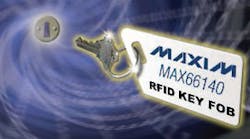As data stored in RF credentials becomes more valuable, efforts to crack, counterfeit, and duplicate cards and credentials will increase. At its base in Germany, Maxim Integrated Products has responded by developing a line of RF-identification (RFID) keys and cards for the automatic-identification, access-control, and electronic-cash markets (see figure). This contactless RFID product family comprises the MAX66000/020/040/100/120/140. It relies on the company's 1-Wire secure-authentication integrated circuits (ICs), which protect intellectual property in embedded systems.
Maxim's new RF devices are packaged in a laminated plastic key fob or ISO thincard format. They are available in either the ISO 14443B or ISO 15693 HF protocol. Each protocol family offers three products: 64-b ROM ID only (MAX66000/MAX66100); ROM ID plus 1-kb EEPROM (MAX66020/MAX66120); or ROM ID plus 1-kb EEPROM and SHA-1 authentication (MAX66040/MAX66140). Custom form factors are available as well.
Both the MAX66040 and MAX66140 employ the secure hash algorithm (SHA-1)a proven technology designed by the United States' National Security Agency (NSA) to protect a system's critical data without using expensive encryption techniques or an untested, proprietary protocol. SHA-1 is a market-tested ISO standard that is publicly available. This standard is designed to maintain the integrity of the stored data so that one can verify the authenticity of any credential.
